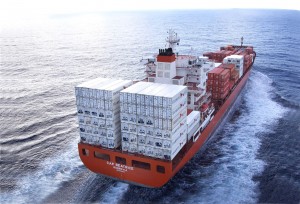International demand for Australian lamb continued to strengthen in September, with exports reaching the highest monthly volume on record at 21,084 tonnes.
 Trade was up 23 percent or almost 4000 tonnes on September last year.
Trade was up 23 percent or almost 4000 tonnes on September last year.
All major markets contributed to the growth in lamb exports, led by the Middle East, US and China.
Trade to Middle Eastern customer countries surged 32pc year-on-year during September, to 6100t, while shipments to the US were up 34pc to 4263t. Demand from China also remained strong, with export volumes reaching 3824t for the month, – up 14pc on the same time last year.
Mutton exports also showed solid growth in September, rising 17pc, year-on-year.
The EU was one of the few key markets that registered a decline in lamb exports in September, with volumes back 24pc year-on-year, to 755t. That was likely due to strong domestic lamb production in the UK over the past couple of months, which saw Australian lamb shipments fall 19pc in September to 660t.
Lamb exports to Papua New Guinea, Japan and Canada totalled 885t (up 5pc), 741t (up 36pc) and 559t (up 25pc), respectively.
Calendar year to date, chilled and frozen lamb exports have now reached 173,028t, up 13pc on the same nine months last year.
With such high export volumes at this stage of the year, it seems increasingly likely that supplies will tighten over the coming months and particularly into 2015, MLA suggests.
Strength in US trade
Most of the increase in trade into the US was in frozen legs, although higher volumes were also recorded for chilled legs and frozen shoulders.
Trade to the US for the 2014 calendar year to date has now reached 33,624t – currently the largest individual country for Australian lamb exports. The mutton trade to the US was also larger year-on-year during September, with broken carcases and legs making up the bulk of the volume and all of the actual growth. Mutton exports reached 832t, bringing the year-to-date total to 8401t – 22pc higher than the same period in 2013.
While Australian lamb exports to the Middle East jumped 32pc on last year during September, mutton shipments were considerably higher, being up 168pc to on 4121t.
Export growth was recorded almost across the board, in terms of major lamb and mutton cuts and destinations, with the lamb trade to Bahrain the only large market to record a lower volume than last year.
Jordan was the largest lamb market in the region, accounting for 1755t, followed by the UAE, Qatar, Bahrain and Saudi Arabia. Whole carcases remain the dominant form of lamb traded (4012t, or 66pc of lamb exports to the region), with a large proportion of these chilled and airfreighted. Of the total volume of lamb exported to the Middle East in September, 72pc was chilled, to better align with the markets’ preference for ‘fresh.’
For mutton, Saudi Arabia was the largest market, with 1526t, followed by the UAE, Kuwait and Oman. Mutton is generally frozen, in contrast to the chilled lamb trade, and whole carcases (1921t) and legs (1530t) accounted for 82p of the total September volume.
Strong growth in mutton
During September, Australian mutton exports continued to rise, increasing 39pc compared to August and 17pc higher than the same time last year, at 15,144 tonnes.
For the first nine months of the year, mutton shipments have reached 129,053t, up 9pc from the corresponding period in 2013, with greater demand across most export markets, particularly throughout Asia and the Middle East.
China accounted for the majority of Australian mutton shipments in September, with 27pc of total market share, at 4137t – 71pc higher month-on-month, yet easing 23pc compared with last year.
The second largest export destination for Australian mutton was the Middle East, receiving 4121t for the month, more than double last year’s volume and 38pc above the five-year average.
Mutton exports to Malaysia totalled 1426t in September, up 32pc on the previous month and 22pc above the same time in 2013, while shipments to Taiwan were up 83pc on August and more than doubled year-on-year, at 903t. The US also continued its gains during the month, taking 832t, up 6pc on the corresponding month last year and increasing 3pc on the five-year average.
While international demand has been strong, sheep slaughter has been at high levels, partly due to the strong prices, which has fuelled the high export volumes. Going forward, given the prolonged high sheep slaughter this year, a slowdown is anticipated during 2015, subsequently resulting in lower export volumes.

HAVE YOUR SAY